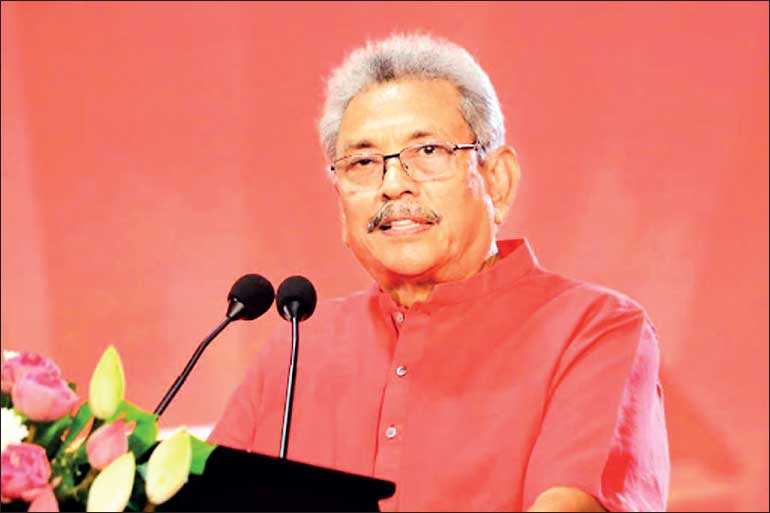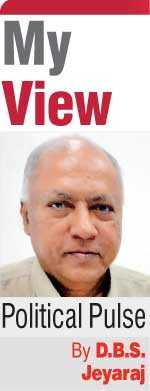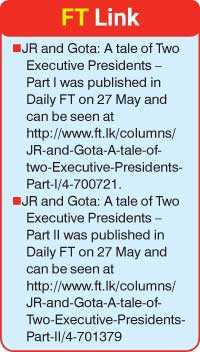Tuesday Nov 25, 2025
Tuesday Nov 25, 2025
Wednesday, 17 June 2020 00:30 - - {{hitsCtrl.values.hits}}

Today the country functions without a Parliament. Much of the prevalent confusion and uncertainty could have been avoided if President Rajapaksa was more flexible. But the President for reasons of his own has been rigid
The entry of Nandasena Gotabaya Rajapaksa into the presidential race in 2019 brought about a paradigm shift in the mode and manner of contesting elections by major political party fielded presidential candidates. In the past all candidates who fancied themselves as prospective executive presidents paid special attention to minority community parties and voters in Sri Lanka. Gotabaya Rajapaksa changed all that in practice.
Many reasons in favour of an elected executive president were trotted out by the J.R. Jayewardene-led United National Party (UNP) Government in 1978 when it introduced the executive president system to Sri Lanka. One of the plus points mentioned was that the executive presidency was advantageous to the numerical minority ethnicities of the country. This assertion that the executive presidency was beneficial to the minority communities of Sri Lanka did have a certain degree of validity.
This was because the votes of the minority communities were capable of influencing the final outcome in a Presidential Poll. In an islandwide Presidential Election – apart from the Tamils and Muslims concentrated in the Northern and Eastern Provinces – all minorities scattered in the other seven southern provinces too could have a comparatively greater say in electing a president. Therefore political parties representing minority community interests generally favoured a directly elected president in an islandwide election.
For instance, when the 21-member Steering Committee appointed by the Constitutional Assembly set up to draft a new Constitution by the Sirisena-Wickremesinghe Government presented its interim report on 21 September 2017, four parties representing the Muslims, Up Country Tamils and Sri Lankan Tamils of Sri Lanka jointly submitted an addendum to the interim report.
The parties concerned were the Sri Lanka Muslim Congress (SLMC), the All Ceylon Makkal Congress (ACMC), the Tamil Progressive Alliance (TPA) and the Eelam People’s Democratic Party (EPDP). According to the proposals submitted by the SLMC-ACMC-TPA-EPDP quartet the President would be the Head of State and Head of Government. The President was to be elected by the people directly at a Presidential Election.
Abolishing the executive presidency in its present form
This was at a time when the UNP which introduced the executive presidency had changed its stance to that of abolishing the executive presidency in its present form. It wanted the current powers of the presidency to be reduced drastically and limited to specific functions only. The UNP was also supportive of the whittled-down president being elected by the Parliament instead of direct election by the whole country as at present. At that time the Tamil National Alliance (TNA) was also of the same position as that of the UNP in relation to abolishing the executive presidency in its present form.
Despite the UNP-TNA stance, the other four minority parties differed on this. They wanted a president directly elected in a country-wide election. Former National Co-existence, Dialogue and Official Languages Minister and Tamil Progressive Alliance (TPA) Leader Mano Ganesan told this column then: “We are in favour of an executive presidency that is elected directly by the people. It would provide minorities more space for political bargaining. However the presidential powers shall be what were prescribed in the original draft of the 19th Amendment. It is a low-powered presidency but directly elected by the people.”
 |
 |
From the time of the first executive Presidential Election in 1982 there was a general acceptance that winning a sizeable number of minority community votes was necessary to win a Presidential Election. All of the presidential candidates representing major political parties made it a point to campaign and woo the ethnic minority votes. The winners were also those who garnered the greater number of minority community votes in addition to majority community votes. This was applicable to J.R. Jayewardene, Ranasinghe Premadasa and Chandrika Bandaranaike Kumaratunga. This pattern changed in 2005 when Mahinda Rajapaksa defeated Ranil Wickremesinghe with a narrow margin.
In that election it was Ranil who got the most number of minority community votes but he was deprived of victory because he could not get the bulk of Tamil votes in the Northern and Eastern Provinces due to the LTTE-enforced boycott supported by the TNA. With the quantum of minority community votes reduced, Wickremesinghe was not able to bridge the deficit in majority community votes and win. This happened again in the 2010 elections too. In the clash between the ‘war victor’ President and ‘war victor’ Army Commander, the bulk of the Sinhala people opted for Mahinda Rajapaksa over Sarath Fonseka. Although Tamil and Muslim votes were cast in very large numbers for Fonseka, the future Field Marshall failed then because an overwhelming number of Sinhalese supported Rajapaksa.
This trend changed in 2015 when Maithripala Sirisena broke away and crossed swords with his erstwhile leader Mahinda Rajapaksa. Maithri won. Although Mahinda got more votes from the Sinhala Buddhist constituency, they were not adequate to counter the preponderant support received by Maithripala from the minority community votes. With Sirisena’s victory the viewpoint that minority community support was necessary for a president to be elected began gaining ground again. In that context many analysts and political commentators strongly doubted the chances of Gotabaya Rajapaksa winning in 2019 because he would not have gained the minority community votes in bulk.
Gota proves his critics wrong
Gota however proved his critics wrong and won. The significant aspect of his campaign was that Gotabaya focused primarily if not solely on Sinhala voters alone although he did pay lip service to the non-Sinhala voter also. A few meetings were held in minority community dominant areas also but the target vote was clearly the Sinhala Buddhist and to a lesser extent the Sinhala Christian constituency. Unlike other candidates Gota did not address any minority related issues in his campaign. Instead of ethno-specific issues, Gota promised national security, economic upliftment, development and employment. He pledged equal treatment for all in this.
After victory Gotabaya Rajapaksa got himself sworn in as president at the historic Ruwanweliseya in Anuradhapura. The Elara-Dutugemunu symbolism was easily discernible. A news report in ‘The Hindu’ filed then by its Colombo Correspondent Meera Srinivasan stated as follows: “The main message of the election is that it was the Sinhala majority vote that allowed me to win the presidency,” the former Defence Secretary said. “I knew that I could win with only the votes of the Sinhala majority. But I asked Tamils and Muslims to be a part of my success. Their response was not what I expected. However, I urge them to join me to build one Sri Lanka,” he said in a televised speech.
The influence of the minority community vote in electing or not electing presidents and the role of the minority community political parties in forming governments with stable majorities had given some minority party leaders an exaggerated sense of their political importance. Some boasted of being kingmakers (and queenmakers). This kind of crowing was not liked by many in the numerically-large Sinhala majority. Gota tapped into this subterranean reservoir of resentment and succeeded. So when the new President addressed Parliament for the first time and delivered his policy speech, he took a crack at the minority political leaders. This is what he said:
“The people who elected me to office desired a profound change in the political culture of this country. They rejected political agendas founded on race. The majority of the people proved that it is no longer possible for anyone to manipulate and control the politics of this country by playing the role of kingmaker. I invite the politicians concerned to understand this reality. I call upon all to join together in the national undertaking to develop this country, and to reject the politics based on petty agendas that have sown division in our society in the past. We must always respect the aspirations of the majority of the people. It is only then that the sovereignty of the people will be safeguarded.”
It could be seen therefore that Gotabaya Rajapaksa went against the established campaigning procedure of appealing to the ethnic minority vote and instead got elected by catering primarily to the Sinhala vote. Having done so the new President was faced with a Parliament where his Sri Lanka Podujana Party (SLPP) and its allies were only a minority. His brother the SLPP supremo was only the Leader of the Opposition. The incumbent Prime Minister commanded a majority in the House through the support of the UNP and minority community parties. Parliament was scheduled to end its term only in August 2020.
The 19th Constitutional Amendment
The 19th Constitutional Amendment restrained the new President from dissolving Parliament until March 2020. Gotabaya Rajapaksa was the first executive president to be elected to office after the 19th Amendment came into force. Many constitutional pundits had opined that the President was now a ceremonial figurehead only. Events however proved that 19 A or no 19 A, the executive presidency created by JR would be vibrantly active when a dynamic person like Gota held that office.
Naturally the new President was eager to form his own government with his brother as Prime Minister. However the same 19 A that prevented him from immediately dissolving Parliament had also empowered the post of the prime minister. If the incumbent Premier had a majority in Parliament there was no way in which the President could remove or replace him. His predecessor Sirisena had tried to do so in 2018 and failed miserably.
What was interesting in this scenario was that the potential tussle would have been an acid test to ascertain whether the 19th Amendment had really empowered the Prime Minister and Parliament vis-à-vis the presidency. It appeared that Ranil Wickremesinghe was game to test it out by not resigning his post. But then Wickremesinghe’s bete noire Sajith Premadasa and his cronies undercut Ranil by resigning their ministry posts and giving Gota a walkover. Thus Ranil was compelled to give in and thereafter it was a cakewalk for Gota who went on to appoint his Government with Mahinda as PM.
President Gotabaya was once again faced with constraints in Cabinet formation due to 19 A. The number of ministers, state ministers and deputy ministers was restricted. But this was not a huge problem for Gota who always wanted a small Cabinet. It was however an issue for the Prime Minister who had to satisfy a number of people by giving them positions because of political compulsions. Gota had a Government of 16 Cabinet ministers and 38 State ministers. Elder brother Mahinda was given a lot of ministries including Finance.
19 A also prevents the president from holding any ministerial portfolio. Thus former Defence Secretary Gotabaya could not be defence minister in the Cabinet headed by him. Interestingly Gota did not appoint another as cabinet minister of defence, not even Mahinda “Aiya”. Instead he appointed his other elder brother Chamal Rajapaksa as State Minister of Defence without delegating any key functions.
However Gota appointed retired Major General Kamal Gunaratne as Defence Ministry Secretary. Gen. Gunaratne functions as Secretary of the Defence Ministry without a de jure defence minister in charge though everyone knows who the de facto defence minister is. Furthermore Kamal Gunaratne has been appointed as Head of quite a few Presidential Task Forces also. Arguably Gen (Retd.) Kamal Gunaratne is today Sri Lanka’s most powerful bureaucrat if one may dare call him that.
Administrative approach
Another distinct difference between JR and Gota was in their approach towards working through Parliament and functioning with a Presidential Secretariat. J.R. Jayewardene did not provide for a Cabinet appointed from outside Parliament. JR was also averse to a powerful Presidential Secretariat as a parallel centre of power to the Cabinet. Why was that?
In response to Prof. Wilson’s specific query on that issue, JR replied: “I must say I am very reluctant to appoint advisers who will be around the president. The reason is that I wish the president to have only his prime minister and the cabinet of ministers as advisers because they represent the people as Members of Parliament.”
J.R. Jayewardene also outlined this position at the convocational address of the University of Sri Lanka on 31 May 1978. He said then: “I wish during my term of office to create precedents that are worthy of following. First, I will always act through the Cabinet and Parliament, preserving the parliamentary system as it existed without diminution of their powers. Second, I will not create a group known as the President’s men and women who will influence him.”
In Gota’s case his administrative approach seems to be the opposite. Gotabaya has been President for more than six months. During this time he has appointed a Premier and Ministers from Parliament as stipulated by the Constitution. However there is a big question mark as to whether they are indeed wielding any real power or are merely titular holders of office. Cabinet briefings have become comedies enhanced further by the jocular pronouncements of facetious spokespersons. The Information Department has become a white elephant with all news releases of importance emanating from the President’s Media Division.
The President and his Prime Minister are siblings. It is often cited that this enables them to engage smoothly in a working partnership as opposed to Sirisena and Wickremesinghe who were at loggerheads with each other. But the buzz on the political grapevine hums differently. There is an impression that the PM and ministers are being side-lined under a style of governance where hand-picked appointees to high offices and Coordinating Secretariats and Task Forces dominated by retired and serving Defence personnel carry more clout than ministers. There are apprehensions that an extra-parliamentary group of Presidential confidantes is calling the shots as opposed to those elected to Parliament.
This unsatisfactory state of affairs has been further aggravated by the spread of the COVID-19 pandemic and the “plight” of Parliament. As is well-known the “old” Parliament was dissolved as soon as he could do so by the President 2 March this year. Fresh elections scheduled for 25 April were postponed due to the COVID-19 pandemic spread. A fresh election was fixed for the date of 20 June. It was clear that the three-month deadline for a new Parliament to convene could not be met on or before 2 June. The President however refused to rescind the 2 March gazette proclamation and bring the dissolved Parliament back to life. He was also reluctant to convene Parliament for a special purpose under Article 70(6) in response to an emergency.
Constitutional crisis fears
Fearing a constitutional crisis after 2 June, several concerned citizens and political parties filed eight Fundamental Rights applications before the Supreme Court. After 10 days of hearings a five-Judge bench headed by Chief Justice Jayantha Jayasuriya in a unanimous decision denied leave to proceed for the petitioners by dismissing all eight FR petitions. No reasons have been given. Subsequently the Election Commission has fixed 5 August as the new election date. There are still doubts as to whether elections could be held as scheduled if the coronavirus spread escalates again. There is also speculation that the EC would definitely go ahead with polls on a staggered basis at least if the pandemic does erupt again in some districts.
Elections being held followed by the convening of a new Parliament will be good for the country and people. The learned lawyers appearing for the petitioners in the FR case applications did paint a bleak picture about the Constitution being violated if Parliament did not re-convene or meet by 2 June. The date has passed and there is no Parliament. Today the country functions without a Parliament. Much of the prevalent confusion and uncertainty could have been avoided if President Rajapaksa was more flexible. But the President for reasons of his own has been rigid.
As stated in the first and second parts of this article, what we have today is a powerful president with a dissolved Parliament who steers the ship of state with the aid of a ‘caretaker’ Cabinet and a Prime Minister who did not command a majority in the last Parliament. Only the President elected with a 52% mandate last year remains as a “legitimate” authority in a legislative vacuum. Furthermore President Rajapaksa’s style of governance under the prevailing circumstances has led to a centralisation of power under Presidential authority.
What seems paradoxical in the current situation is the fact that the 19th Constitutional Amendment had decreased the powers of the president and increased those of the prime minister and Parliament. Due to exceptional circumstances, Gotabaya Rajapaksa is arguably Sri Lanka’s first standalone Executive President without even a Parliament. In this he may have surpassed even the wildest imagination of Junius Richard Jayewardene who introduced the presidential system of government in 1978.
(D.B.S. Jeyaraj can be reached at [email protected])
